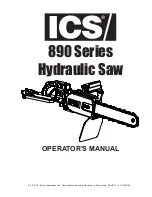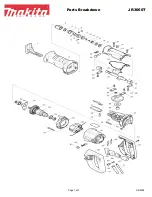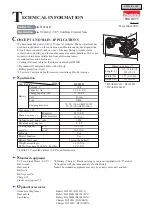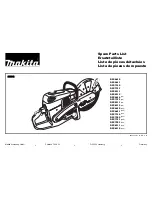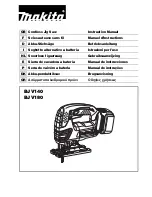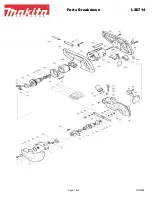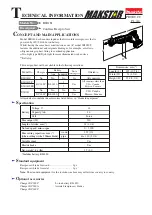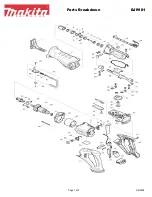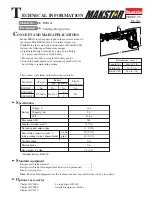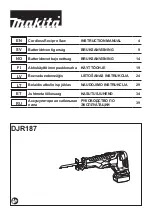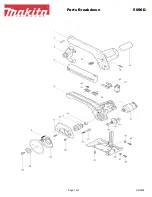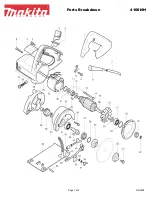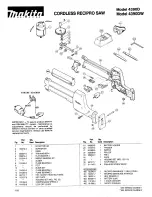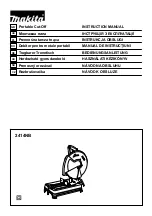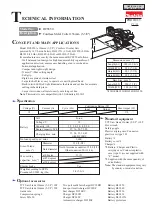
24
EngLIsh
14
Cutting disc
15
Guard
16
Spindle lock
17
Lock-down hook
18
Spark deflector
19
Spark deflector screw
20
Lock-down chain
21
Date code
Intended Use
Your D28710 chop saw has been designed for the cutting of
variously shaped steel materials.
DO nOt
use under wet conditions or in the presence of
flammable liquids or gases.
The D28710 chop saw is a professional power tool.
DO nOt
let children come into contact with the tool.
Supervision is required when inexperienced operators use
this tool.
•
Young children and the infirm.
This appliance is not
intended for use by young children or infirm persons
without supervision.
• This product is not intended for use by persons (including
children) suffering from diminished physical, sensory or
mental abilities; lack of experience, knowledge or skills
unless they are supervised by a person responsible for their
safety. Children should never be left alone with this product.
ASSEMBLY AND ADJUSTMENTS
WARNING: To reduce the risk of serious personal
injury, turn tool off and disconnect tool from power
source before making any adjustments or removing/
installing attachments or accessories.
An accidental
start-up can cause injury.
Removing and Fitting a Cutting Disc
(Fig. A, B)
1. With the arm in the rest position, use the lip
22
to slide the
guard
15
back. Leave the guard retracted (Fig. B).
2. Press and hold down the spindle lock
16
(Fig. A).
3. Rotate the cutting disc
14
until it locks.
4. Using the hex key
11
, remove the bolt
23
by turning
counterclockwise and then remove the flat washer
24
and
the retaining flange
25
(Fig. B).
5. Check that the spacer
26
is in place against the flange
27
.
6. Replace the cutting disc
14
. Make sure that the
new disc is placed onto the spacer
26
in the correct
rotational direction.
7. Secure the blade with the retaining flange
25
, the flat
washer
24
and the bolt
23
.
8. Move the guard back down and release the spindle lock
16
.
9. Adjust the cutting depth as necessary.
Adjusting the Cutting Depth (Fig. A)
The cutting depth can be adjusted to meet the wear of the
cutting disc.
1. Make a dry run with the tool switched off and check
for clearance.
2. If adjustment is required, proceed as follows:
a. Loosen the lock nut
6
a few turns.
b. Turn the depth stop bolt
5
in or out as to achieve the
required cutting depth.
c. Tighten the lock nut
6
.
WARNING:
Always adjust the depth stop to its original
position when replacing the cutting disc.
Clamping the Workpiece in Position
(Fig. A, C)
The tool is equipped with a material clamp
9
(Fig. A).
1. Pull the lever
13
toward the handle
12
(Fig. C1).
2. Push the clamp shaft
28
forward until the jaw
29
is almost
touching the workpiece.
3. Press the lever
13
toward the jaw
29
until it engages with
the clamp shaft
28
.
4. Rotate the handle
12
clockwise and clamp the
workpiece securely.
5. To release the workpiece, rotate the
handle
12
counterclockwise.
WARNING:
• To increase the cutting capacity, place a spacer
block
30
under the workpiece
31
. The spacer block
should be slightly narrower than the workpiece
(Fig. C2).
• Support long workpieces using a piece of wood
32
(Fig. 3C). Do not clamp the cut off end
33
.
Quick Travel Feature (Fig. C1)
The clamp has a quick travel feature.
• To release the clamp, rotate the handle
12
one or two
turns counterclockwise and pull the lever
13
toward the
handle
12
.
Setting the Clamping Position (Fig. C4)
The clamping position can be set to match the cutting disc.
1. Remove the fence bolts
34
using the hex key
11
.
2. Move the fence
8
as required.
3. Re-fit the fence bolts
34
and tighten them to lock the
fence
8
.
Adjusting the Angle of Cut (Fig. D)
The tool can be used for mitre cuts up to 45°.
1. Loosen the fence bolts
34
to release the fence
8
.
2. Set the fence
8
to the required angle. The angle can be
read on the scale
35
.
3. Tighten the fence bolts
34
to lock the fence
8
.
Checking and Adjusting the Mitre Scale
(Fig. A, D)
1. Loosen the fence bolts
34
to release the fence
8
(Fig. D).
Summary of Contents for D28710
Page 1: ...D28710 Final Page size A5 148mm x 210mm ...
Page 3: ...1 Fig A 21 2 1 3 4 5 6 7 8 9 10 11 12 13 14 15 16 17 18 19 20 17 5 6 ...
Page 4: ...2 Fig C1 Fig C2 Fig B 22 27 26 15 14 25 24 23 11 28 29 13 8 12 30 31 ...
Page 5: ...3 Fig C3 Fig C4 Fig D Fig E 32 33 11 8 34 3 8 34 35 36 37 ...
Page 6: ...4 Fig F Fig G ...































